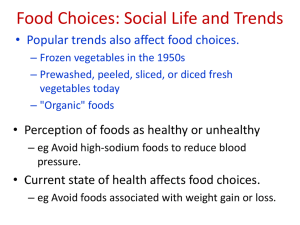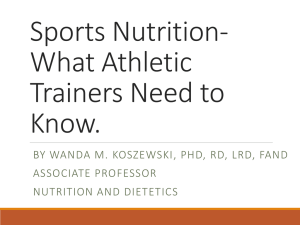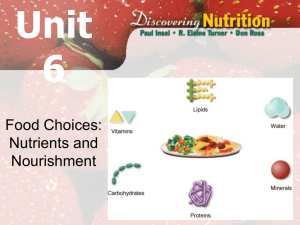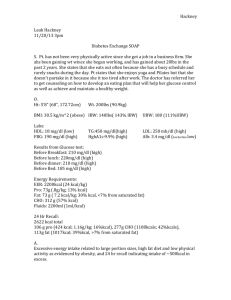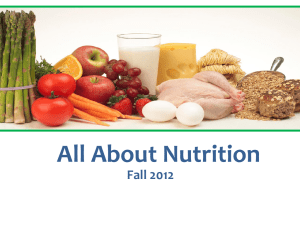Type 2 DM - Case Study
advertisement
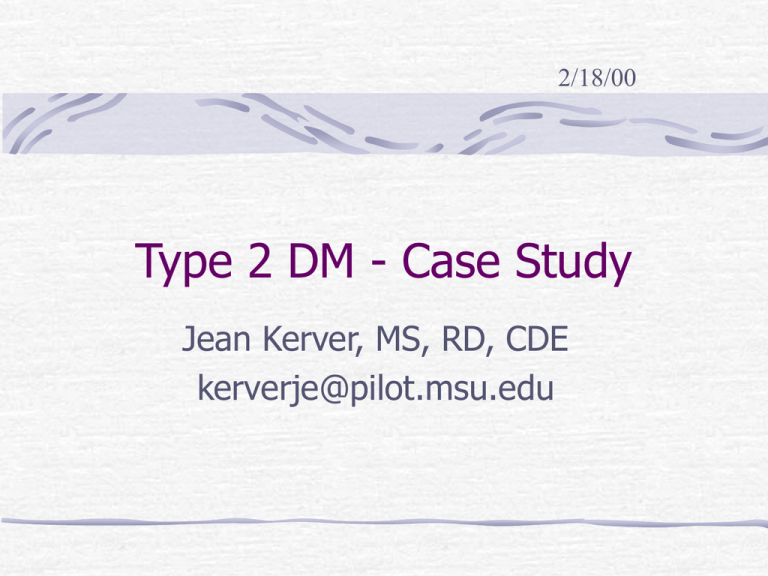
2/18/00 Type 2 DM - Case Study Jean Kerver, MS, RD, CDE kerverje@pilot.msu.edu DR is a 45 y.o. male; Ht: 5’9”; Wt: 215 lbs Present complaint: polydipsia, polyuria, fatigue. Past med hx: Type 2 DM x 5 yrs. Meds: None; NKDA. Labs: No SBGM; serum glucose=285 mg/dL 1 hr ppd; HbA1C=9.2% urinary glucose=2+; temp=98.8 F. Family med hx: Grandma type 2 DM at age 60 yrs Social hx: architect; lives alone; nonsmoker; no regular physical activity. Diet hx: no known food allergies; no supplements (vit/min or other); no special diet; drinks 2 beers qd after work; brkfst at home; lunch out—fast food or deli type; dinner at home —cooks or orders take-out food; seldom snacks. Breakfast (24-hr recall) 2 cups raisin bran 1 lg banana 1 cup whole milk 8 oz orange juice Lunch 4 oz corned beef 1 oz swiss cheese 2 slices rye bread ½ cup cole slaw 2 tbsp russian dressing 1 small bag potato chips 12 oz juice cocktail 4 starch, 1 fruit 380 kcals 2 fruit 120 kcals 1 high fat milk 150 kcals 2 fruit 120 kcals 4 med-fat meat 300 kcals 1 high-fat meat 100 kcals 2 starch 160 kcals 1 vege, 1 fat 70 kcals 2 fat 90 kcals 1 starch, 1 fat 125 kcals 150 kcals Dinner (24-hr recall, cont’d) 1 cup fried rice 4 oz Hunan chicken (fried) 4 oz shrimp and cashews 2 bottles beer 1 lg orange Total kcals: Protein: Fat: Carb: 3411 14% 40% 46% 3 starch, 3 fat 375 kcals 4 high fat meat 400 kcals 4 high fat meat 400 kcals 2 beer 300 kcals 2 fruit 120 kcals Total Kcals: 3360 How Many kcals Should He Have? Ht: 5’9”; Wt: 215 lbs IBW: 106 lbs + (9” x 6 lbs) = 160 lbs % IBW = 215 lbs /160 lbs = 134% AdjBW = 0.25 (215-160) + 160 = 174 lbs (79 kg) 25 kcals/kg = 25 x 79 = 1975 kcals/d 24-hr = 3411 kcals – 500 kcals= 2900 kcals Calculation of Initial Dietary Pattern Total kcals = 2000 50% CHO = 0.50 x kcal = 0.50 x 2000 = 250 g CHO 4 kcal/g CHO 4 20% PRO = 0.20 x kcal = 0.20 x 2000 = 100 g PRO 4 kcal/g PRO 4 30% FAT = 0.30 x kcal = 0.30 x 2000 = 67 g FAT 9 kcal/g FAT 9 ADA Exchanges Food Gp CHO (g) PRO (g) FAT (g) Starch Kcals 15 3 - 80 Meat - 7 3-8 55-100 Vege 5 2 - 25 Fruit 15 - - 60 Milk 12 8 0-8 90-150 Fat - - 5 45 Negotiate, Then Convert Into Exchanges First, determine how many servings of milk, fruit, and vegetables the patient is willing to eat each day. Next, add up the CHO from the milk, fruit, and vegetable groups and subtract that amount of CHO from the total amount of CHO needed. Then divide the remaining amount of CHO into starch exchanges. Do the same for PRO and FAT. Negotiate, then Convert CHO (250 g) No. of CHO (g) PRO (g) FAT (g) Exchanges Milk Vege Fruit Starch (12) 2 (8) 24 (5) 3 (2) (15) 10 - 6 - - (3) - 60 (15) 10 16 15 4 (5 - 2%) 150 30 Convert PRO (100 g) No. of CHO (g) PRO (g) FAT (g) Exchanges Milk Vege Starch Meat (12) 2 (8) 24 (5) 3 (2) (15) 10 - 6 (3) 150 - 7 16 15 10 (5 - 2%) - 30 (7) (5) 49 35 Convert FAT (67 g) No. of CHO (g) PRO (g) FAT (g) Exchange s Milk Meat Fat (12) 2 (8) 24 - 16 (7) 7 10 (5) 49 - 4 (5 - 2%) - 35 (5) 20 Diet Pattern Food Group No. of Exchanges Starch CHO (g) PRO (g) FAT (g) (15) (3) - 10 Meat 150 - 30 (7) 7 Vege 49 (5) 3 Fruit (2) 15 (15) 4 Milk 35 - 6 - - (8) (5 - 2%) 60 (12) 2 Fat (5) 24 - 16 - 10 (5) 4 20 Totals: 249 101 65 Rx Totals: 250 100 67 Metabolic Effects of Exercise in Type 2 DM Lipolysis Decreased Plasma Insulin Lower Blood Glucose Increased peripheral glucose uptake Increased Insulin Sensitivity When Therapy Changes Multiple Dose Regimen NPH + Humalog BID Add Bedtime NPH to Orals Combinations of Oral Agents: Metformin + Sulfonylureas, etc. Monotherapy Oral Agents: Sulfonylureas, Metformin, Troglitazones, etc. Meal Planning and Physical Activity Diabetes Education Tell patient what to expect Individualize-always give choices Be systematic-prioritize Discuss coping strategies Special situations Evaluating Outcomes in DM Treatment Outcomes Can Be: Clinical Life Glycemic Control care HbA1c Blood lipids Weight/BMI Blood pressure Complications Economic length/stay Quality of Participation in -ER visits -costs to health plan - SMBG - keeps appts. - Rx refills Better work attendance Q of Life survey
